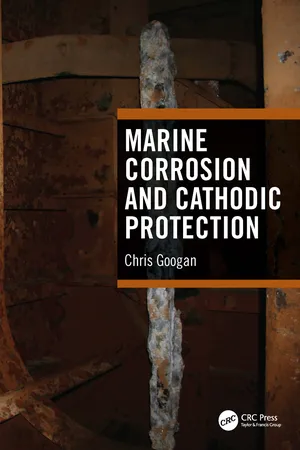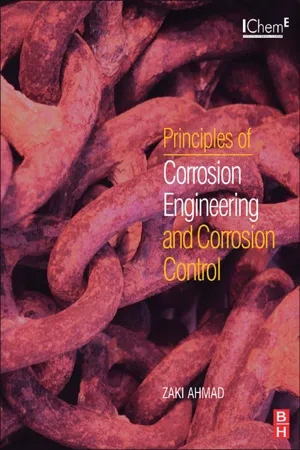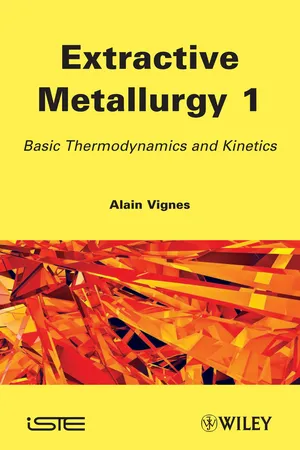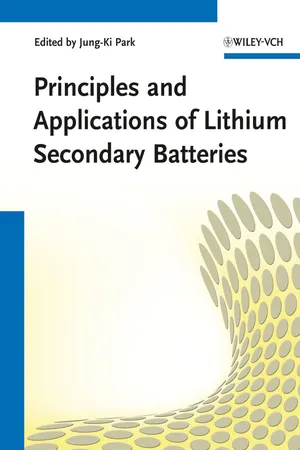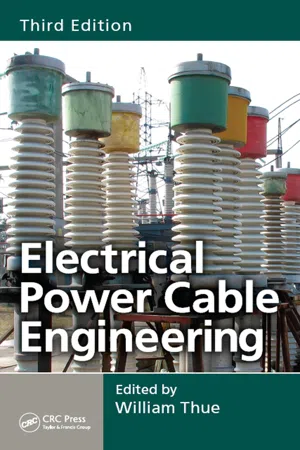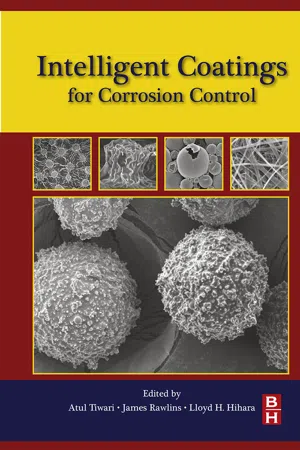Technology & Engineering
Anodic Cathodic Reaction
Anodic and cathodic reactions are fundamental processes in electrochemistry. The anodic reaction involves the loss of electrons, leading to oxidation, while the cathodic reaction involves the gain of electrons, leading to reduction. These reactions occur at separate electrodes in an electrochemical cell and are essential for processes such as corrosion, batteries, and electrolysis.
Written by Perlego with AI-assistance
8 Key excerpts on "Anodic Cathodic Reaction"
Learn about this page
Index pages curate the most relevant extracts from our library of academic textbooks. They’ve been created using an in-house natural language model (NLM), each adding context and meaning to key research topics.
- eBook - ePub
- Chris Googan(Author)
- 2022(Publication Date)
- CRC Press(Publisher)
Thus, anodic and cathodic rates are in balance. There is no nett change, but the situation is not static. This prompts two questions:- What controls the rates of the forward (anodic) and backward (cathodic) reactions?
- How can we measure these rates?
Historically, the methods used to measure electrochemical reaction rates were developed ahead of the relevant theory. In keeping with this history, we will touch briefly on the measurement, and will then proceed to the explanation.5.2 Electrochemical experiments
In this part of our discussion, we will keep our focus on the relatively straightforward example of reversible electrodes; that is, electrodes that are in equilibrium with their environments, such as copper in a copper sulfate solution. These electrodes are not corroding.5.2.1 Some terminology
All branches of science and engineering have evolved their own terminologies. Electrochemistry is no different. It has its own language. This has the advantage of speeding up communication between those already familiar with the science, but at the cost of making some concepts seem impenetrable to those wishing to get involved for the first time. With this in mind, we provide simple definitions of some basic concepts that we will be using as we go forward. We are also taking the opportunity to remind ourselves of some terms that we have already met.5.2.1.1 Electrodes, electrolytes, anodes, cathodes and half-cells
By now we should already be familiar with these terms. For our purposes, an electrode is an electronic conductor (usually a metal such as steel), placed in contact with an ionic conductor (usually an electrolyte solution such as seawater). The means by which electric current passes between the electrode and the electrolyte solution is an electrode process. Electrode processes can be either anodic, which releases electrons into the electrode, or cathodic, which consumes electrons at the electrode’s surface.Anodic and cathodic processes usually occur together on the surface. However, it is possible for these processes to be spatially separated, in which case the different parts of the electrode surface are referred to as anodic and cathodic sites. In the extreme, the anodic and cathodic activity might become separated onto separate electrodes, termed anodes and cathodes. This is, of course, what we seek to achieve in CP, with the structure functioning as the cathode, and the CP - Zaki Ahmad(Author)
- 2006(Publication Date)
- Butterworth-Heinemann(Publisher)
CHAPTER 2BASIC CONCEPTS IN CORROSION
Publisher Summary
This chapter discusses basic concepts of corrosion. The formation of a corrosion cell is essential for corrosion to take place. A corrosion cell is essentially comprised of the following four components: anode, cathode, electrolyte, and metallic path. Anodic and cathodic reactions are discussed in the chapter. Cathodic reactions are reduction reactions that occur at the cathode. Electrons released by the anodic reactions are consumed at the cathode surface. There are various types of corrosion cells: galvanic cells, concentration cells, electrolytic cells, and differential temperature cells. The relationship between free energy and equilibrium constant is shown in the chapter. A chemical reaction at constant temperature and pressure will only occur if there is an overall decrease in the free energy of the system during the reaction. Absolute single electrode potential is a characteristic property of a metal. All metals have characteristic electrode potentials. They can be measured with respect to a standard electrode, such as Standard Hydrogen Electrode (SHE). The chapter concludes with some examples of pourbaix diagram.BASIC CONCEPTS IN CORROSION
For corrosion to take place, the formation of a corrosion cell is essential. A corrosion cell is essentially comprised of the following four components (Fig. 2.1 ).Figure 2.1 Corrosion cell in actionAnodeCathodeElectrolyteMetallic path.Anode: One of the two dissimilar metal electrodes in an electrolytic cell, represented as the negative terminal of the cell. Electrons are released at the anode, which is the more reactive metal. Electrons are insoluble in aqueous solutions and they only move, through the wire connection into the cathode. For example, in a battery, zinc casing acts as the anode. Also in a Daniel cell, zinc is the anode as oxidation occurs on it and electrons are released (Fig. 2.2- eBook - ePub
Extractive Metallurgy 1
Basic Thermodynamics and Kinetics
- Alain Vignes(Author)
- 2013(Publication Date)
- Wiley-ISTE(Publisher)
Chapter 8Electrochemical Reactions
8.1. Overview of electrochemical processes
A chemical reaction is a reaction where only chemical species (neutral molecules and positively or negatively charged ions) are involved. An electrochemical reaction is a reaction where chemical species and free electrons are involved. The two elementary electrochemical reactions are:– oxidation : liberation of electrons. For a metal (in the solid state) immersed in an electrolytic solution, the reaction is a dissolution, which gives a metallic ion in solution (corrosion):[8.1.1]– reduction : absorption of electrons. For a metallic ion in an aqueous solution (heterogeneous precipitation, see Chapter 5 , section 5.6.1 ):[8.1.2]Various overall reactions are the result of elementary electrochemical reactions:– redox chemical reactions resulting from two simultaneous elementary electrochemical reactions where the electrons are directly transferred between the reactants. They are homogeneous chemical reactions (see Chapter 5 , section 5.2.1.1 - Jung-Ki Park, Jung-Ki Park(Authors)
- 2012(Publication Date)
- Wiley-VCH(Publisher)
An electrochemical cell is the smallest unit of a device that converts chemical energy to electric energy, or vice versa. In general, a battery has multiple electrochemical cells, but it may be used to refer to a single cell. An electrochemical cell consists of two different electrodes and an electrolyte. The two electrodes of different electric potential create a potential difference when immersed in the electrolyte. This potential difference is also known as electromotive force.Electric potential, denoted by V , is the potential energy of a unit charge within an electric field, and electromotive force drives current in an electric circuit. Redox reactions occur at each electrode due to this force and the generated electrons pass through the external circuit. To maintain charge neutrality of the electrolyte, redox reactions continue at the electrodes until the cell reaches electrochemical equilibrium.2.1.2 Battery Components and Electrodes
As explained above, a battery (or an electrochemical cell) is a device that converts chemical energy to electric energy, or vice versa, using redox reactions. Figure 2.1 shows the components of a cell, including the cathode, anode, electrolyte, and a separator to prevent short circuits between the electrodes.Figure 2.1 A battery or electrochemical cell (discharge).When electrochemical redox reactions occur at the electrodes, ions are shuttled between the anode and the cathode through the electrolyte. At the same time, electron transfer takes place between the two electrodes. These electrons travel through the external wire connecting the two electrodes, thus forming a closed circuit.In a discharging battery, electrochemical oxidation (oxidation, A → A+ + e− ) of the electrode proceeds at the negative terminal, which is termed an anode. Discharging is the process of converting chemical energy carried by the battery into electric energy. Electrons transferred from the negative terminal through the external circuit engage in reduction (reduction, B+ + e− → B) at the positive terminal, which is known as a cathode. The electrolyte serves as an ionic conductor between the two electrodes and should be distinguished from an electron conductor.While redox reactions at the electrodes are irreversible for primary batteries, they are reversible and repeatable in secondary batteries. Here, “reversible” means that redox reactions are repeated within the same electrode. One advantage of secondary batteries over primary batteries is that they can be recharged repeatedly. In the case of secondary batteries, both oxidation and reduction reactions can occur at the same electrode. It means that a cathode during discharging can be an anode during charging. However, in the conventional point of view, the terms remain the same for both charging and discharging, with the oxidative electrode as the anode and the reductive electrode as the cathode during discharging, spontaneous electrochemical reaction.- eBook - ePub
- William A. Thue, William A. Thue(Authors)
- 2017(Publication Date)
- CRC Press(Publisher)
The first basic requirement for corrosion is the presence of an electrolyte and two electrodes—an anode and a cathode. These electrodes may consist of two different kinds of metal, or may be different areas of the same piece of metal. In any case, there must be a potential difference between the two electrodes so that current will flow between them. A wire or some path is necessary for the flow of electrons that are negatively charged particles moving in the wire from the negative to the positive.At the anode, positively charged atoms of metal detach themselves from the solid surface and enter into solution as ions while the corresponding negative charges, in the form of electrons, are left behind in the metal. For copper:Cu ∘→Cu2+ +e −The detached positive ions bear one or more positive charges. The released electrons travel through the metal or other conducting media to the cathode area. The electrons reaching the surface of the cathode through the metal meet and neutralize some positively charged ions (such as hydrogen) that have arrived at the same surface through the electrolyte. In losing their charge, the positive ions become neutral atoms again and may combine to form a gas.2H ++ 2 e →H 2The release of hydrogen ions results in the accumulation of OH− ions that are left behind and increase the alkalinity at the cathode—hence making the solution less acidic. Other common reactions occurring at the cathode are shown as follows. Their occurrence depends on such factors as pH, type of electrolyte, etc.4H ++O 2+ 4e −→ 2H 2OO 2+ 2H 2O + 2e −→H 2O 2+ 2OH −O 2+ 2H 2O + 4e −→ 4OH −For corrosion to occur, there must be a release of electrons at the anode and a formation of metal ions through oxidation or disintegration of the metal. At the cathode, there must be a simultaneous acceptance of the electrons by a mechanism such as neutralization of the positive ions or formation of negative ions. Actions at the cathode and anode must always go on together, but corrosion occurs almost always at areas that act as anodes. - eBook - ePub
- David E.J. Talbot, James D.R. Talbot(Authors)
- 2018(Publication Date)
- CRC Press(Publisher)
3 Thermodynamics and Kinetics of Corrosion Processes 3.1Thermodynamics of Aqueous CorrosionThermodynamics provides part of the scientific infrastructure needed to evaluate the course and rate of corrosion processes. Its principle value is in yielding information on intermediate products of the complementary anodic and cathodic partial reactions that together constitute a complete process. The structures and characteristics of these intermediate products can control the resistance of a metal surface to attack within such wide limits as to make the difference between premature failure and sufficient life for its practical function.An illustrative example concerns the behaviour of iron in water containing dissolved oxygen. In neutral water, the anodic reaction produces a soluble ion, Fe2 + , as an intermediate product and although the final product is a solid, it is precipitated from solution and does not protect the metal, whereas in alkaline water, the anodic reaction converts the iron surface directly into a thin protective solid layer. Such effects can be explained by thermodynamic assessments.Classic works develop the principles of chemical thermodynamics ab initio , but a concise summary of the background to the basic relations needed is given by Bodsworth in a companion volume of the present CRC series and is recommended to the reader.3.1.1Oxidation and Reduction Processes in Aqueous SolutionCorrosion science is frequently concerned with the exchange of electrons between half-reactions, that is, anodic reactions that produce them and complementary cathodic reactions that consume them, and some means of accounting for the electrons is essential. Such an accounting system is based on the concept of oxidation that has wider implications in inorganic chemistry than the name suggests. It is approached through the idea of oxidation states. - eBook - ePub
- Jeffrey Gaffney, Nancy Marley(Authors)
- 2017(Publication Date)
- Elsevier(Publisher)
Chapter 10Oxidation-Reduction Reactions and Electrochemistry
Abstract
This chapter explains the principles of oxidation and reduction, including the roles of the oxidizing and reducing agents and how to determine oxidation states. The construction and operation of a galvanic cell is overviewed and the function of the anode and cathode explained. The importance of balancing the half reactions first when balancing oxidation-reduction chemical equations is stressed. Also covered are the importance of standard cell potentials and the designation of the standard hydrogen electrode as the electrode by which all others are measured. Methods of determining the cell potentials both under standard and nonstandard conditions are given. A Case Study on the use of cathode protection in structural metals and the role of concentration cells in corrosion are discussed to stress the importance of oxidation-reduction principles to engineering. Other topics discussed are the application of oxidation-reduction chemistry in electrolysis and battery and fuel cell construction.Keywords
Oxidation-reduction; Galvanic cell; Cathode; Anode; SHE; Standard potentials; Nernst equation; Electrolysis; Battery; Fuel cellOutline10.1Oxidation-Reduction Reactions10.2The Galvanic Cell10.3Balancing Oxidation-Reduction Equations10.4Standard Cell Potentials10.5Reactions at Nonstandard Conditions: The Nernst Equation10.6Electrolysis10.7Batteries10.8Fuel CellsImportant TermsStudy QuestionsProblems10.1 Oxidation-Reduction Reactions
Many common chemical reactions, such as the acid-base reactions, discussed in Chapter 5 , are based on the transfer of a proton (H+ ) between reactants. Another common type of chemical reactions involves the transfer of electrons between reactants. The branch of chemistry that studies this type of reactions is electrochemistry , the study of chemical processes that cause electrons to move. These chemical reactions that involve the transfer of electrons from one reactant to another are called oxidation -reduction reactions, or redox - eBook - ePub
- Atul Tiwari, Lloyd Hihara, James Rawlins(Authors)
- 2014(Publication Date)
- Butterworth-Heinemann(Publisher)
cell only indicates if the reaction is thermodynamically possible or impossible, and therefore, the study of kinetics is required to obtain the rates of the corrosion reaction.1.2.2 Kinetics
In the study of corrosion, polarization diagrams3 are used to determine the rates of metal dissolution, oxygen reduction, and hydrogen evolution. The thermodynamic driving force for the electrochemical reaction is measured in potential, E , on the vertical axis of the polarization diagram. The kinetics of the electrochemical reaction are measured in current, I , on the horizontal axis of the polarization diagram. Notice that the anodic (Equation 1.1 ) and cathodic reactions (Equations 1.2 –1.5 ) involve the transfer of electrons, and, therefore, their rates are proportional to the current. Based on Faraday’s law, the moles, N , of species reacted is related to the current, I :N =I tn F(1.10)where t is the duration of the current I , F is Faraday’s constant (or charge on one mole of electrons), and n is the moles of electrons participating in the reaction:O + n e → R(1.11)Anodic reactions generate anodic currents, I A , and cathodic reactions generate cathodic currents, I C . The currents are often normalized with respect to the surface area, A , of the electrode:i A=I AA(1.12)i C=I CA(1.13)Depending on the metal and environment, metals may have active, passive, or active-passive electrochemical behavior. Active metals and alloys do not form protective passive films and show increasing anodic currents (Figure 1.1 ) as the potential is increased above the open-circuit or corrosion potential (E corr ). Passive metals form protective passive films and have very low dissolution currents (Figure 1.2 ) at potentials more positive than E corr . Active-passive metals (e.g., Cr, Ni)4 generally show active, passive, and transpassive regimes on the anodic polarization diagram (Figure 1.3 ). In the active regime from E corr to the primary passive potential (E pp ), the metal dissolution rate increases as the potential increases. In the passive regime, a protective oxide passive film forms on the metal at potentials greater than E pp causing the current to dramatically decrease. In the transpassive regime at more noble potentials, the anodic current again increases either due to passive-film break down leading to metal dissolution or the evolution of oxygen.2
